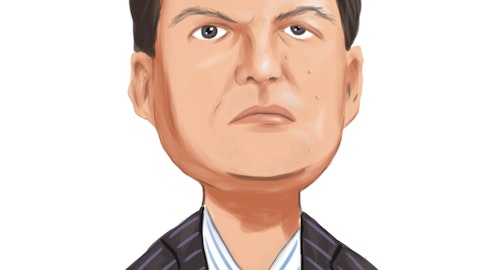Signet Jewelers Limited (NYSE:SIG) Q1 2024 Earnings Call Transcript June 8, 2023
Signet Jewelers Limited beats earnings expectations. Reported EPS is $1.78, expectations were $1.49.
Operator: Hello everyone, and welcome to the Signet Jewelers’ Q1 Earnings Call. My name is Emily and I’ll be coordinating your call today. [Operator Instructions] I will now turn the call over to our host Rob Ballew. Please go ahead.
Rob Ballew: Good morning. Welcome to Signet Jewelers’ first quarter earnings conference call. On the call today are Signet’s CEO, Gina Drosos; and Chief Financial, Strategy and Services Officer, Joan Hilson. During today’s presentation, we will make certain forward-looking statements. Any statements that are not historical facts are subject to a number of risks and uncertainties. Actual results may differ materially. We urge you to read the risk factors, cautionary language, and other disclosure in our annual report on Form 10-K, quarterly reports on Form 10-Q, and current report on Form 8-K. Except as required by law, we undertake no obligation to revise or publicly update forward-looking statements in-light of new information or future events.
During the call, we will discuss certain non-GAAP financial measures. For further discussion of the non-GAAP financial measures, as well as reconciliations of the non-GAAP financial measures to the most directly comparable GAAP measures, investors should review the news release we posted on our website at www.signetjewelers.com/investors. With that, I’ll turn the call over to Gina.
Gina Drosos: Thank you, Rob. We’re happy to have you joining your first Signet earnings call today and appreciate the extensive experience you bring. And thanks to all of you for joining us today. Before getting into our prepared remarks, I want to thank our Signet team. Our company continues to be recognized as a great place to work because of the outstanding people we work alongside. In a pressured quarter, we delivered on our commitments, thanks to their agility and excellent customer service. I’m proud to lead this team. There are three key messages, I’d like to reinforce in my remarks today. First, we achieved our revenue and bottom line commitments in Q1, despite macroeconomic headwinds that worsened late in the quarter.
Additionally, as we predicted, there were fewer engagements in the quarter resulting from COVID’s disruption of [dating three] [ph] years ago. Given softening trends in late April, we’ve leveraged high margin innovation in services and fashion, as well as strategic promotions to quickly respond to competitive pressures. These results reflect the agility we built in our team and our flexible operating model. Second, we are adjusting our guidance for the year reflecting current market conditions, lowering revenue expectations based on increasing macro pressure on consumer spending. On the bottom line, our operating model continues to deliver at a double-digit annual rate. However, we are intentionally choosing to invest in the capabilities that we believe are creating sustainable competitive advantages and driving market share growth to expand the moat around our business.
We have the advantage of having built a fortress balance sheet that fuels our ability to invest in a period of disruption, which we believe gives us significant competitive advantage. Third, we remain confident in our mid-term goals that we outlined at our April Investor Day. In fact, our proprietary consumer insights give us increased confidence that engagements will begin to recover at the end of [fiscal 2024] [ph], and we’re positioning ourselves to accelerate market share growth. Turning to the quarter, we delivered nearly $1.7 billion in sales and more than $106 million in non-GAAP operating income, both at the high-end of our guidance. We achieved this despite 50% of our business being in bridal, which we expected to decline and in an environment that deteriorated late in the quarter, which we’ve seen continue in the second quarter.
The swing factors in recent consumer confidence, lower tax refunds, economic concerns triggered by regional bank failures, and continued inflation led to a weakening trend in spending across the jewelry industry of an additional 10 points that we estimate based on external reports. Bridal and macroeconomic conditions were two important drivers in the quarter, so I’ll comment on both of them. We expected the low double-digit decline in engagements that we saw this quarter. Similar to the fourth quarter, we expected to see units decline, but we also expected growth in average transaction value, which did not materialize. This reflects the accelerated macro pressures on spending, as well as a heightened promotional environment. Those factors that we expect to continue.
We believe we are growing market share and bridal in this environment. In fashion, we continue to see pressure at lower price points as has been the case for the past year. However, later in the quarter, we began to see degradation at higher price points between $1,000 and $5,000 in fashion. Price points remain strong at $5,000 and above. This price erosion continued into the second quarter. Nonetheless, our intentional focus on building out our fashion category over the last three years, which has grown to 36% in that time to become a bigger portion of our mix has positioned us to gain market share and is having the positive impact we’ve designed for in this current environment. I’ll talk more about our guidance update shortly, but I want to first look at the value of the investments we’ve made to differentiate Signet from competitors and position us to gain market share.
In particular, our banner portfolio, our services business, and our digital and data capabilities, all of which were important strengths in Q1. Our broad portfolio of banners is working as it is designed to do. As we’ve repositioned it, Jared is a good example. Jared now represents an important mezzanine between fine jewelry and luxury jewelry. In each of the last nine quarters, Jared has increased average transaction value versus previous year by providing the higher quality metal, elegant cuts, and exclusive brands that Jared customers want. And we’re piloting a preferred assortment in select stores that has driven a 600 basis point improvement in sales versus the balance of the fleet and a 1,500 basis point improvement to average ticket sales.
We expect to roll it out more broadly in the months ahead. The value and potential of our services business continues to be evident. Services grew more than 5%, compared to this time last year, reflecting the notable progress across our services offerings, a key driver with our extended service agreements or ESAs. The attachment rate for ESAs increased more than 2 points exiting the quarter with higher velocity. This is a particularly impressive result since our highest attachment is typically in bridal. Custom is another good example. We expect a custom to decline in the quarter at a similar rate to merchandise sales. Yet this growing service bucked the trends, increasing penetration, and contributing to core margin expansion. We’ve been building our services offerings based on deep consumer research and it’s working.
The improvements we’ve made in custom and repair drove a service margin increase of 340 basis points, compared to the prior year. Our loyalty program is demonstrating meaningful growth as well. We recently introduced the option to enroll in our loyalty program when first creating an account on one of our banner sites, creating a frictionless point of entry for our customers. This enhancement has enabled a more than 50% increase in members in the quarter. This matters because our loyalty numbers are more frequent purchasers and have a 20% higher spend than non-loyalty members. These examples represent continued progress toward our midterm goal of $1.2 billion in service business revenue, as well as an important step change in the way services performed as a category.
Historically, services revenue has trended alongside merchandise, often impacted by the same drivers. This quarter, services is a standout category, and a clear reflection of our investments. We’ve changed the trajectory of this part of our business through ESA product differentiation, increased digital access and visibility, and increased training. The final strength I’d like to highlight is the value our digital and data analytics capabilities. Our investments in digital continue to be a differentiator and a bright spot for us in the current environment, increasing penetration in the quarter. We believe that’s both an indication of the macro environment where consumers are browsing and researching more before they buy and also the investments we’ve made to create a great customer experience.
Our digital net promoter score, or NPS, is now at an all-time high, having grown three points over the last quarter and nine points, compared to this time last year, and 96% of promoters say they will shop with us again. As consumer expectations continue to increase, we are updating our digital experience, meeting customers how and where they want to shop, with us at a scale that’s hard to match. We implemented more than a dozen new priority feature launches this quarter and we’re on-track for an additional 20 in the second quarter. These features include enhancements to online merchandise presentation, messaging, appointment booking, and services. With these and future improvements to come, we are sharply focused on customer delight and increased conversion.
Beyond digital, our proprietary data and ability to mine it for insights is a significant source of competitive advantage. We see its value in Bridal, for example. As we mentioned at our Investor Day, we have identified and tracked a proprietary list of 45 milestones that trace a couple’s journey through four major relationship stages, meeting, exclusivity, committed, and engagement. What our data has shown is that once couples experience at least 27 of these milestones, it becomes highly likely that they will move to engagement. For example, couples traveling together is one of the top milestones later in the couple’s journey to engagement. We see evidence of this milestone currently across our data sources, including online search activity.

Copyright: NejroN / 123RF Stock Photo
searches for couples vacation on TikTok are currently twice what they were in Q4. Google searches for travel or vacation together are up more than 30%. In fact, multiple data sources that we track for other key proprietary indicators are also up significantly. The key point is that we’re seeing the engagement milestones occurring as expected, which reinforces our confidence that engagements will begin to recover as we approach the end of the year. We are investing to win as this unfolds. Personalized marketing is another example of our data capabilities. Our marketing efficiency and effectiveness continue to improve as we personalize our approach, including a 9% increase to our return on ad spend in the first quarter with advertising as a percent of sales flat compared to this time last year.
Our customer data platform, which enables our personalized journeys, is still relatively new in implementation. That said, we’ve already built nearly 30 million customer profiles and the platform is configured to activate across channels like email, SMS texting, web, and social. I want to put this into perspective for you. We estimate those 30 million customer profiles represent roughly 40% of U.S. jewelry customers who make a purchase in a given year, and we’ve been adding over 1 million new profiles every month. The marriage of these two things are proprietary consumer insights and our leading customer data platform is a powerful combination that doesn’t exist at our scale anywhere else in the North America jewelry industry. Our unique consumer insights capability enables us to see and understand pre-engagement couples as they make progress through their relationship toward engagement, and our personalization capability enables us to interact with them at important steps, increasing the likelihood that they’ll come to us when they’re ready to get engaged.
This also generates insights into all the milestone moments that come later in their lives and enables us to build life time relationships with them. This integrated approach to our insights and customer data is at the heart of our transformation, and our long-term growth potential. We will continue to invest behind it as we get better and better every year. One final example of how we’re leveraging data is the way we’re driving out product cost without compromising quality and innovation. A recent example is a sourcing technology that we’ve activated, which we call the loop. This is a leading sourcing system that allows us to benchmark standardized component costs, establish should cost pricing models, and create transparency and cost negotiations across our network, lowering costs, and matching product demand and supply needs with the right vendors across all our banners.
We’re early in our implementation, but already in Q1, we estimate that we avoided mid-single-digit cost increases to [loose stones] [ph]. Based on our early success, we are now doubling our expectation of savings from $20 million to $40 million this year and believe we can ultimately save up to $200 million annually over time. This level of cost transparency gives us a clear competitive advantage, particularly with current macro headwinds. The point of these examples is to underscore that the investments we’ve made and continue to make to strengthen critical capabilities and create competitive advantages are working. Our financial strength allows us to keep investing to widen the mode around our business and position Signet for ongoing market share gains.
I’ll touch briefly now on our guidance update. As a result of the deteriorating macro environment and impact on consumer spending patterns we saw late in Q1 and throughout May, we are revising guidance to reflect continuation of these trends for the balance of the year. We’ve updated our forecast to account for a lower range of top line outcomes and now expect revenue for the year to be between $7.1 billion to $7.3 billion. Based on sales data in May and June for the industry, we believe this guide positions us to grow market share as current trends are pointing to a larger decline across the industry. As I said earlier, our model provides double-digit operating margins even in a tough macroenvironment. We are maintaining investments this year of nearly $75 million in OpEx to enhance our digital and IT capabilities and up to $200 million in capital, which is a demonstration of our increasing confidence in the recovery of engagements and our ability to achieve our mid-term goals.
These investments will pressure margins by approximately 1 point, placing us temporarily below our double-digit target in a range of 8.9% to 9.2%. Importantly, these investments strategically position us to take advantage of the expected recovery in bridal that will begin later this year and capture share when the current macro headwinds received. Our flexible operating model is in place and working, and our fortressed balance sheet gives us this opportunity. We’re also taking action in three key areas. We’re heightening our focus on innovation at the right price points working to stimulate demand through relevant newness within our assortments, personalized customer journeys, and strategic promotions, all while balancing our inventory position.
We believe our lean inventory and [heightens turn] [ph] gives us the opportunity to bring newness to markets faster than our competition, and our scale allows us to create excellent value. Secondly, we are more than doubling our cost savings initiatives from [$100 million] [ph] this year to $225 million to $250 million. And third, we’re accelerating our ongoing fleet optimization and plan to close up to 150 stores over the next 12 months that are not meeting our expectations for productivity. Joan will provide more perspective, but I’ll close just by coming back to the core messages we’re focusing on today. We delivered our revenue and bottom line commitments in Q1 despite significant pressure, reflecting our agility and flexible operating model.
We’re adjusting our guidance to reflect current macroeconomic conditions, while continuing to invest intentionally and the capabilities that we believe are driving market share growth, and we remain confident in both the recovery of engagements and in our ability to achieve the mid-term goals that we outlined at our April Investor Day. On that note, I’ll pass it over to Joan.
Joan Hilson: Thanks, Gina, and good morning, everyone. I want to reinforce today’s message by focusing on one of the most important factors in our control, our flexible operating model. We are able to proactively respond to the current business environment and continue to strategically invest to drive market share gains precisely because of our model and our strong balance sheet. Turning to the quarter. We delivered nearly $1.7 billion in sales. This represents a sales decline of 9.3% and 13.9% on a same store sales basis. Traffic was down in the quarter in a mid-single-digit range on a relatively flat ATB and lower conversion. We leveraged strategic promotion towards the end of the quarter as we saw trends soften. In addition, we were able to drive growth in services of over 5%, notably outperforming merchandise performance in the quarter.
This is a clear competitive advantage for us in the jewelry industry given our scale and skilled network of [Artisan Jewelers] [ph]. Our e-commerce penetration increased 500 basis points to nearly 23%, compared to a year ago, reflecting our strategic investments in digital. Turning now to gross margin, we delivered non-GAAP gross margin of $633 million or 38% of sales, a decline of a 160 basis points, compared to the prior year. Core merchandise margin expanded more than 100 basis points, compared to last year, including the positive contribution of services, discount controls, and strategic sourcing initiatives that generated product cost savings. That benefit was offset by deleveraging of fixed costs such as occupancy on lower sales, as well as the 50 basis point impact relating to product mix of the digital banner.
Moving on to SG&A, our non-GAAP spend of $524 million or 31.4% was 240 basis points higher than last year and reflect deleveraging of fixed costs on lower sales and incremental investments and capabilities. And we delivered on our cost savings expectations for the quarter as we continue to identify sourcing opportunities and leverage the flexibility inherent in our labor model. Importantly, in the quarter, our financial services team reached a three-year extension with Bread Financial to further secure stability and the cost of our financial services program. All of this builds to a non-GAAP operating margin of a $106.5 million or 6.4%, which compares to 10.6% in the prior year. The reduction included approximately 200 basis points related to strategic investments and the Blue Nile acquisition for which we expect the margin pressure to abate in the third quarter.
The balance of the reduction in rate is related to deleveraging of cost on a mid-teen comp sales decline. Turning to the balance sheet, we ended the quarter with over $650 million of cash and equivalents, down $270 million compared to a year ago. Excluding $200 million in legal settlements paid this quarter, and the nearly $390 million acquisition of Blue Nile in the third quarter of last year, we would have increased our cash by over $300 million. We ended the quarter with just under $2.2 billion in inventory. Our inventory was down $33 million compared to last year. Excluding Blue Nile, our core inventory was down a $128 million or 6% lower, reflecting our use of data analytics to inform working capital management on a store-by-store basis.
We’ve maintained nearly a 1.4x [turn] [ph] with our capital efficiency efforts and our inventory is healthy, paving the way for continued newness in our assortment. We continue to value the strength of our debt position with an adjusted debt-to-EBITDA leverage ratio of 2.1x and 1.7x on a net debt basis, we remain in a healthy position to execute on our capital priorities and well below our target of less than 2.75x. Capital returns to shareholders continues to be a priority for Signet. Year to date, we have repurchased $39 million or 500,000 shares and have $761 million in repurchase authorization remaining. We also announced a quarterly cash dividend on common shares this morning of $0.23 per share for the second quarter, payable August 25th to shareholders of record on July 28th of this year.
Consistent with our rigorous cost control, we are proactively flexing our model to respond to trends in our business. As Gina mentioned, we are increasing our cost savings target for the year from $100 million to a range of $225 million to $250 million. We expect to achieve this by maximizing our flexible labor model, which allows for dynamic staffing both in stores and in our customer care centers. Leveraging AI as a growing capability across many business areas to drive cost out of the system, accelerating the benefits of vertical integration, while working with our supply chain to drive cost transparency, driving out administrative costs that do not impact customers. And finally, accelerating the benefits of our investments and capabilities to build competitive advantages.
Further, as part of our ongoing evaluation of underperforming stores, we now expect to close, up to 150 stores over the next 12 months, largely at expiration. We take a holistic approach to drive share, market-by-market leveraging our leading consumer insight capabilities at scale. We perform a continuous review of mall, off-mall, and digital channel activity in the given trade area to ensure we are most effectively supporting our connected commerce experience. Most of these closures will likely be in traditional mall locations. Compared to fiscal 2020, off-mall and outlet comparable revenues have outperformed malls by over 800 basis points, and we’ve seen over 70% growth in comparable e-commerce revenue. Further, compared to fiscal 2020, comp sales of stores in our top 7 markets have outperformed our remaining fleet by more than 500 basis points as we continue our strategy to drive share in top markets.
I’ll now turn to guidance. As a result of declining trends in late April, and for the second quarter to date, we expect the current softness will continue throughout the year and have updated our guidance to account for a lower range of top line outcome. We believe the current trend reflects the impact of increasing macro pressure on discretionary categories, including the jewelry industry. For example, going into Mother’s Day, we expect it to see a $40 million to $50 million shift from Q1 into Q2 as a result of timing. And we did not see this shift materialize. Additionally, we began to see softening at higher price points, which previously had been relatively insulated and lower price points remained under pressure. With this in mind, we expect revenue in the second quarter to be in the range of $1.53 billion to $1.58 billion.
We expect non-GAAP operating income in the range of $85 million to a $100 million. This outlook includes a small portion of the cost action we detailed earlier, as well as the continuation of strategic investments and the impact of the Blue Nile acquisition in the quarter. Looking to the full-year, we now expect fiscal 2024 revenue in the range of $7.1 billion to $7.3 billion, with the fourth quarter year-over-year performance expected to be slightly higher than the second and third quarters. In addition to bridal recovery and the 53rd week in fourth quarter of this year, we will be lapping the UK strikes during last year’s holiday season. We now expect revenue for the year to decline between 7% to 9% after reducing our full-year revenue expectation by approximately $550 million.
We anticipate that we will outperform the industry, despite a higher bridal mix thus driving market share gains. We now expect non-GAAP operating income in the range of $635 million to $675 million, reflecting lower revenue, the additional cost savings impacting both gross margin and SG&A, primarily in the second half of the year, and maintaining strategic investments. This represents a non-GAAP operating margin of approximately 9% or a low double-digit margin, excluding the investments showcasing the true flexibility of our model. This translates to a non-GAAP earnings per diluted share in the range of $9.49 to $10.09, which reflects a reduction of interest expense for the year and share repurchases through today to partially offset reduced expectations in operating income.
Before we move on to Q&A, I want to thank our team members who exemplify our culture for their resilience and agility, which consistently drive results and serves our customers. And now, I’d like to open the line for Q&A.
See also 25 Best Beaches in California and 10 Best Coal Mining Stocks to Buy.
Q&A Session
Follow Signet Jewelers Ltd (NYSE:SIG)
Follow Signet Jewelers Ltd (NYSE:SIG)
Operator: Thank you. [Operator Instructions] Our first question today comes from the line of Ike Boruchow with Wells Fargo. Please go ahead, Ike. Your line is open.
Ike Boruchow: Hey. Good morning. I guess, two questions. I think one for Joan, one for Gina. Joan, on the 150 store closures, any chance you could tell us – you said they’re underperforming, but what’s the revenue and EBIT associated with those stores? Are they actually losing money? Just kind of curious if there’s any more color there? And then, Gina, understanding the lowering of the guide, you talked about accelerating some of the investments, which is why the margins are below your double-digit target, does that mean that when we get into next year, assuming, you know, engagement starts to inflect the way you think, that you should that you believe you’ll return to a 10% operating margin? Just kind of curious how we can take those comments that you made? Thanks.
Joan Hilson: So, I’ll start Ike with the stores. Up to a 150 stores that we believe are underperforming are a mix. In fact, of stores that are not cash flow positive and stores that are down-trending, and we believe with the current view of the year in terms of our guidance that they’re not on the good trajectory, they’re not meeting our labor productivity, or I’m sorry, our store productivity targets. So, it’s a [mixture] [ph].
Gina Drosos: And on the margin, Ike, thanks for that question. So, our operating model is working exactly as we’ve designed it to, and we are operating at a double-digit rate. We’ve chosen this year because we see an opportunity to lean in to invest about a point and to continue to expand our digital and consumer personalized marketing capabilities. We think this really sets us up to drive an accelerated share growth, especially as engagements come back, but on an ongoing basis, we are well-positioned to deliver those double-digit operating margins. This is a temporary decision, intentional decision to invest.
Ike Boruchow: Great. Thank you.
Operator: Our next question comes from Lorraine Hutchinson with Bank of America Merrill Lynch. Lorraine, please go ahead. Your line is open.
Lorraine Hutchinson: Thank you. Good morning. I wanted to follow-up on the new three-year agreement with Bread, how has the lending stand there changed, if at all? Are there any guardrails that give you confidence that they’ll continue to lend to your customer base as they have been?
Joan Hilson: We, you know, within our agreements, we do have very clear guidelines on our lending practices, approval rates. Lorraine, what I’d say about what we’re seeing within our own credit business is that approval rates are in fact down. However, it’s because we see an increase in applications online. So, as you recall, we have the ability to – the customers have the ability to apply for credit, you know, online and those approval rates are lower, and I think, you know, you would see that across, you know, the industry. So, that’s what we’re seeing with approval rates. And our payment penetration rates are up overall and roughly 300 basis points, and I would also say that the amount financed is also up, Lorraine. So, we’re seeing, you know, a good response within the financial services offering.
Our partners of which Bread is, you know, on the prime portfolio, a partner for that. We’re seeing, you know, health and we have a very watchful eye on, you know, as, you know, things move forward, we’ll, you know, keep an eye on if there’s any delinquency or change in and approval rates. I would say that we have, just as a reminder, we don’t have credit risk on our balance sheet. And as you know, we removed that several years ago.




